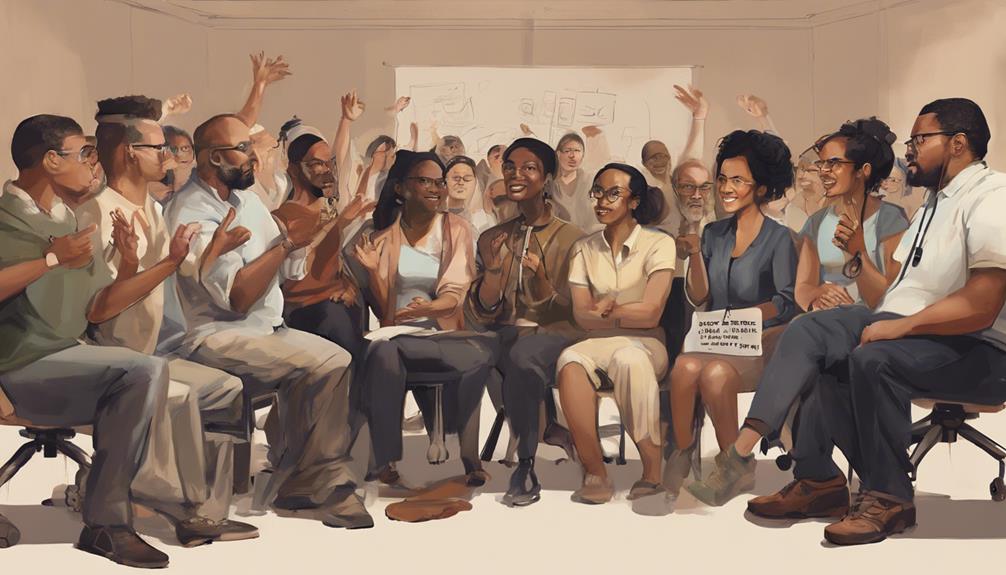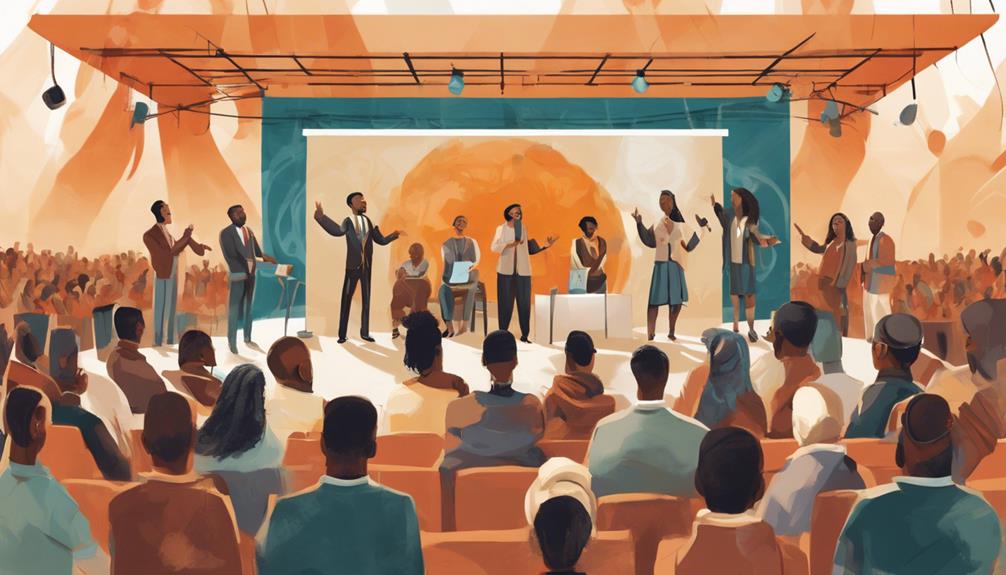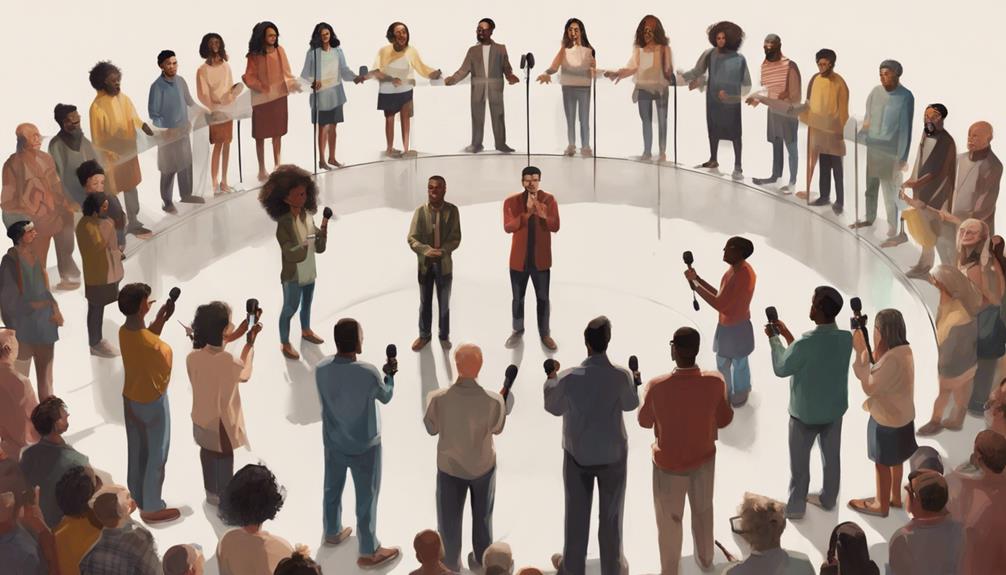To overcome ethnocentrism as a speaker, embrace diversity and cultural sensitivity to enhance communication. Acknowledge differing perspectives to foster inclusivity and effective interactions. Actively listen, engage openly, and promote global empathy in speeches. Avoid stereotypes and judgments to break down barriers and biases. By practicing respect and understanding, you promote inclusivity and bridge cultural gaps.
Key Takeaways
- Embrace cultural diversity in speeches.
- Avoid cultural stereotypes and biases.
- Listen actively to diverse perspectives.
- Incorporate global empathy in communication.
- Foster a culture of understanding and respect.
Understanding Ethnocentrism
To understand ethnocentrism, recognize that it involves the belief in the superiority of your own culture, often causing misunderstandings and communication barriers. Overcoming this mindset requires cultural sensitivity and embracing diversity. By acknowledging cultural differences, you can enhance effective communication and foster inclusivity.
Effective communication hinges on understanding and appreciating the unique norms and values of diverse cultures. Embracing diversity means valuing different perspectives and actively listening to others without judgment. This approach not only breaks down barriers but also builds bridges between individuals from various backgrounds.
Cultural sensitivity plays a pivotal role in mitigating ethnocentrism. It involves being aware of your own biases and assumptions, as well as being respectful and open to learning from others. By cultivating a mindset of inclusivity and acceptance, you can create a more harmonious environment where communication flows freely, and connections are strengthened.
Impact on Communication

When considering the impact of ethnocentrism on communication, you'll find it creates substantial challenges that must be addressed.
Understanding the significance of ethnocentrism awareness is vital in overcoming these barriers.
Together, we can work towards embracing diversity and promoting inclusivity to foster more effective cross-cultural interactions.
Communication Challenges Addressed
Overcoming ethnocentrism directly impacts communication by dismantling barriers rooted in cultural biases and stereotypes. Effective intercultural communication is achieved by acknowledging and addressing the following challenges:
- Cultural Barriers: Ethnocentrism perpetuates misunderstandings and hinders communication by promoting the idea of cultural superiority.
- Cultural Diversity: Embracing diverse cultural perspectives enriches communication by fostering inclusivity and understanding.
- Biases and Stereotypes: Overcoming ethnocentrism involves recognizing and challenging biases and stereotypes that impede meaningful interactions.
- Inclusivity: Acknowledging cultural differences is essential for creating an inclusive environment that promotes effective communication.
- Respect and Empathy: Embracing diversity and inclusivity enhances communication effectiveness by encouraging respect and empathy towards varying cultural viewpoints.
Ethnocentrism Awareness Importance
By understanding the significance of ethnocentrism awareness, you can enhance your communication skills and foster meaningful connections across diverse cultural backgrounds. Cultural relativism plays an essential role in recognizing that different cultural norms exist and are valid within their own contexts.
Embracing cultural diversity in intercultural communication involves acknowledging and respecting the values, beliefs, and practices of others without judgment. This awareness enables you to navigate interactions more effectively by avoiding assumptions based on your own cultural perspective.
When you prioritize ethnocentrism awareness, you create an inclusive environment that encourages collaboration and mutual understanding. By being mindful of your biases and actively seeking to learn about other cultures, you pave the way for meaningful connections to flourish.
Overcoming ethnocentrism is a continuous process that requires openness, empathy, and a willingness to embrace diversity. Through this lens, you can foster genuine relationships and bridge the gaps that hinder effective cross-cultural communication.
Overcoming Barriers Together
Recognizing and addressing ethnocentrism in communication fosters inclusivity and understanding among diverse audiences, leading to more effective cross-cultural interactions and enhanced public speaking experiences.
When overcoming barriers together, you can have a notable impact on communication by embracing cultural diversity, engaging in intercultural communication, valuing different cultural perspectives, being mindful of body language cues, and collaborating with individuals from various backgrounds.
By actively promoting cultural diversity, you create a more inclusive environment where everyone feels valued and respected. Practicing effective intercultural communication skills allows for smoother exchanges and fewer misunderstandings, fostering stronger connections with your audience.
Acknowledging the importance of cultural values enriches your speeches and presentations, making them more relatable and impactful to diverse listeners. Being attentive to body language nuances helps convey respect and understanding across different cultural contexts, enhancing the overall communication experience.
Working together to overcome ethnocentrism elevates the quality of interactions and promotes mutual respect among speakers and audiences.
Strategies for Overcoming

Embracing cultural diversity and inclusivity is fundamental for speakers looking to break through ethnocentric barriers in public speaking. To overcome these barriers, actively listen to diverse perspectives and engage in open communication.
By fostering a culture of understanding and respect for different cultural norms, you can effectively combat ethnocentrism. Developing global empathy and acknowledging the richness of cultural diversity can help you connect with your audience on a deeper level.
Incorporating cultural understanding into your speeches by recognizing and celebrating diversity will show your dedication to inclusivity. Avoiding stereotypes and assumptions about other cultures is essential in bridging the gap created by ethnocentrism.
Importance of Cultural Awareness

You need to understand the significance of cultural awareness in your communication. It's essential for respecting diverse values, norms, and behaviors and fostering inclusivity.
Cultural Sensitivity Importance
Understanding the significance of cultural sensitivity is pivotal in fostering effective communication across diverse cultural backgrounds. Cultural sensitivity and awareness play a significant role in bridging the gaps between individuals from different cultural backgrounds.
Here are five key reasons why cultural sensitivity is essential:
- Respecting Differences: Acknowledging and respecting the diverse beliefs, behaviors, and perceptions of others is vital for building trust and rapport.
- Fostering Inclusivity: Cultural sensitivity promotes inclusivity by creating a welcoming environment where individuals feel valued and understood.
- Enhancing Empathy: Developing cultural awareness cultivates empathy, allowing individuals to see the world from diverse perspectives.
- Adapting Communication: Understanding cultural nuances enables speakers to tailor their message effectively to connect with audiences from varied cultural backgrounds.
- Promoting Understanding: Embracing cultural diversity not only enhances communication effectiveness but also fosters mutual understanding and appreciation among individuals.
Overcoming Bias Strategies
Recognizing and respecting diverse cultural norms and values is essential in overcoming bias through enhanced cultural awareness. By actively engaging in strategies that promote cultural humility, empathy, and respect for diversity, individuals can navigate through diverse environments more effectively. Embracing cultural differences and actively participating in intercultural interactions are key steps in breaking down barriers created by ethnocentrism. Understanding the impact of ethnocentrism and stereotypes is crucial for fostering improved cross-cultural understanding and collaboration in diverse settings. Addressing bias through cultural awareness training not only enhances organizational performance but also fosters diversity and creates a more inclusive work environment.
| Strategies for Overcoming Bias | Importance |
|---|---|
| Promote cultural humility | Foster inclusivity and effective communication |
| Practice empathy and respect | Break down barriers created by ethnocentrism |
| Embrace cultural differences | Improve cross-cultural understanding |
| Engage in intercultural interactions | Enhance collaboration in diverse environments |
Promoting Inclusivity

Embracing diversity and respecting different cultural perspectives are key components in promoting inclusivity. To create a more inclusive environment as a speaker, consider the following:
- Encourage Cultural Sensitivity: Being aware of and respecting the nuances of diverse cultural backgrounds can help in fostering inclusivity.
- Embrace Diversity: Celebrate the differences in cultural backgrounds and perspectives to create a welcoming atmosphere for all individuals.
- Value Diverse Viewpoints: Acknowledging and appreciating the variety of opinions and beliefs can help break down barriers caused by ethnocentrism.
- Promote Open-Mindedness: Encouraging a mindset of openness to new ideas and perspectives can lead to greater inclusivity in your speaking engagements.
- Create a Welcoming Environment: Make sure that your speaking events are inclusive and welcoming to individuals from all cultural backgrounds to enhance audience engagement and understanding.
Building Bridges With Audience

To foster cultural understanding and empathy with your audience, it's essential to engage in effective communication strategies that acknowledge and respect diverse cultural perspectives. Building bridges with your audience involves recognizing the richness of cultural diversity and the importance of inclusive communication. By embracing cultural differences, you can create a more empathetic connection with your listeners, breaking down barriers and fostering a sense of unity.
Effective communication is key to overcoming ethnocentrism and promoting cultural empathy. By actively listening to diverse viewpoints and engaging in open dialogue, you can demonstrate respect for the cultural backgrounds of your audience members. This not only enhances the overall experience for your listeners but also creates a welcoming environment where everyone feels valued and understood.
Frequently Asked Questions
How Can We Overcome Ethnocentrism Barriers in Communication?
To overcome ethnocentrism barriers in communication, you must embrace cultural sensitivity, respect differences, and foster inclusivity. Building empathy and understanding with your audience breaks down barriers. Educate yourself about other cultures to promote cultural empathy.
How Can We Prevent Ethnocentrism in Public Speaking?
To prevent ethnocentrism in public speaking, acknowledge diverse perspectives, use inclusive language, and share cultural anecdotes. Embrace differences, listen actively, and engage in dialogue to foster understanding. Create a welcoming environment for all.
Why Do Speakers Need to Avoid Ethnocentrism?
To connect with diverse audiences effectively, avoid ethnocentrism. By embracing cultural differences, you build rapport and understanding. Overcoming ethnocentrism creates an inclusive speech environment, fostering engagement and meaningful communication with all listeners.
What Is the Strategy for Overcoming Cultural Barriers?
To overcome cultural barriers, understand differences, communicate openly, and embrace diversity. Address stereotypes and prejudices with education and empathy. Encourage dialogue, celebrate differences, and recognize global perspectives. These strategies enhance communication effectiveness and engagement.
How Can Black Speakers Overcome Ethnocentrism in the Speaking Industry?
Black speakers who changed the speaking industry are breaking down barriers by sharing their unique perspectives and experiences. By staying true to their identities and embracing their cultural backgrounds, black speakers can overcome ethnocentrism in the industry. Embracing diversity and inclusion can pave the way for greater representation and opportunities for black speakers.
Conclusion
In a world where diversity is celebrated, it's essential to acknowledge and overcome ethnocentrism in communication. By promoting cultural awareness and inclusivity, speakers can break down barriers and build bridges with their audience.
Remember, understanding different perspectives enriches our interactions and fosters a sense of unity among all. Embrace the power of diversity and watch as your message resonates with a wider audience.










